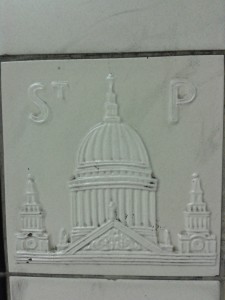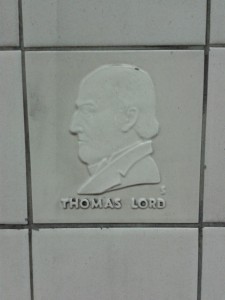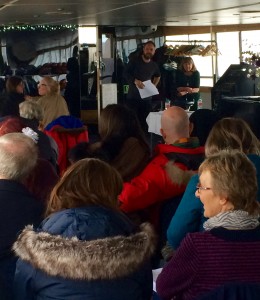Diary of a Guide…Thames, Theft and Tiles?
This week saw me back in Bankside, on the Thames and discovering a surprising find in St John’s Wood.
Tuesday
All wrapped up and thermals donned for this evening’s ‘Bawdy Bankside’ walk for students at the new London campus of the University of West Scotland (www.uws.ac.uk/london). I was rather relieved when we met at their campus in Borough to find that everyone was sensibly dressed for the weather, especially as the students weren’t the hardy Scots I expected but overseas students from China.
The cold English weather had put some of the students off, but those who did brave the cold were enthusiastic about the walk and London, and bombarded me with questions throughout the tour.
Explaining the British way of life, our customs, and our language is one of the joys of being a tour guide. Cultural differences are always interesting, but have you ever tried to explain what a scone is to someone Chinese? It’s not easy. I mean who other than the British really understands why we smother a small fruit cake in jam and clotted cream? And I didn’t even bother to explain the jam then cream or cream then jam thing! I mean, who understands that anyway?
One of the students and I developed a rapport as it turned out we had both climbed Mount Tai, one of the holiest mountains in China (way back in 1996 for me), and we compared notes about the number of steps to the top (7,200), how long it took us (about 5 hours) and how cold it was on the top – much colder than Bankside in February!
This evening’s walk took us past St George the Martyr church with its chalk message board on the north side, which (surprisingly) had no rude messages – at least, I don’t think the Chinese writing is rude?!. Both there and at the site of the old Marshalsea Prison next door, we talked about Charles Dickens and the story of Little Dorritt. Then we moved on to the Crossbones Graveyard (see Diary of a Guide…Prostitutes and Pleasure Gardens), before heading to the original site of the Globe Theatre, the Rose Theatre, and then the current Globe.
Now it’s rare to find someone who hasn’t heard of William Shakespeare, but the students hadn’t, so a long conversation ensued explaining who he was and why he is so important in this country (he is the only writer that is always included on the school national curriculum). We tend to forget that our most famous playwright may not be known around the world, even if Macbeth is currently visiting every country across the globe as part of Shakespeare 400.
After all that culture, it went a bit downhill as I then had to explain that the Winchester Geese were prostitutes. Then I had to explain what a goose was, and then what a prostitute was – I really need to learn Mandarin, it would be so much easier! However, it was Einstein who said: “If you can’t explain it to a six year old, you don’t understand it yourself”, and the same principle applies to visitors from overseas. It was a timely reminder of the guide’s golden rule to never assume that people know what or who you’re talking about.
Thursday
On the way back from a meeting in St John’s Wood with a tour operator about a future job, I took a good look at the underground station and discovered the most wonderful tiles down on the platforms. Designed by Harold Stabler in the 1930s for the London Passenger Transport Board (as the underground was then called), the series of 18 tiles were commissioned by Vice-Chairman Frank Pick and made by Carter and Co (now Poole Pottery).
St John’s Wood is one of only a few stations that still feature the original earthenware London themed tiles. You should still be able to find others at Swiss Cottage, Aldgate East and Bethnal Green, so do seek them out whenever you are passing through.
Saturday
The cold, grey, wet afternoon was the perfect weather for the Museum of London’s ‘Tour the Thames: Crime, Death and Myths’, where I spent the afternoon on the Pride of London pleasure cruiser talking to 125 guests about death and crimes connected with the river.
Scott Wood, author of ‘London Urban Legends’, was my co-speaker and he regaled the audience with tales of ghosts, sewer pigs and Queen Rat! Me, well I covered the cholera deaths, robberies, murders, and executions!
My favourites included the De Beers diamond heist at the O2 in 2000 (back when it was still called the Millennium Dome) which was foiled by the Met Police’s Flying Squad, and really did look like an episode of The Sweeney. As the robbers smashed their way into the glass display cases, ‘visitors’ to the exhibition and ‘cleaners’ pulled guns out of prams and rubbish bins to surround and arrested them. The robbers had planned to get away by speedboat, but that too was cornered in the Thames and the driver arrested. What the robbers didn’t know was that, if they had managed to get away with the largest haul in British history, they would have only had fake diamonds in their hands – the real ones having been replaced with copies when the police knew the heist was planned.
At the Tower of London, the execution of Margaret Pole, Countess of Salisbury, has to be one of the grisliest. This lady, at the age of 70 in 1541, was not going down easily. She refused to put her head on the block and was chased round the execution site with the axeman hacking away at her.
Bridge murders also featured. That of Georgi Markov, at Waterloo Bridge in 1978 (stabbed in his leg with an umbrella containing ricin poisoning while waiting at a bus stop), and Roberto Calvi, found hanging under Blackfriars Bridge in 1982. God’s Banker (he had close links with the Vatican) was found dead with stones in his pockets weighing him down and about £15,000 in various currencies. Real life is often more like Hollywood than, well, Hollywood!
But my personal favourite has to be the murder of Prince Ali Kamel Fahmy at the Savoy Hotel in 1923. Shot in his suite by his own wife, her defence lawyer painted a picture of an abusive marriage with a husband of dubious sexual persuasions, and then played the race card warning against evil foreigners preying on western women. So dramatic was the self defence argument that the jury only took an hour to find Princess Fahmy (Marguerite Laurient) not guilty. Perhaps the jury may not have been so quick to acquit Marguerite if her murky reputation hadn’t been covered up along with her affair with the Prince of Wales (future Edward VIII)!
The weather and subject matter may have been gloomy, but it was cosy and warm as we cruised from Westminster to the O2 along a rather choppy Thames (good job I have my sea legs) in the capable hands of the captain and crew of the Pride of London (www.cruiselondon.co.uk/pride-of-london).
The Museum of London’s next Thames tour (www.museumoflondon.org.uk) is Shakespeare themed to coincide with the 400th anniversary of his death in April. I can’t speak for the crew of the Pride of London, but as Stephano says in The Tempest: “The master, the swabber, the boatswain, and I, The gunner, and his mate, Lov’d Mall, Meg, and Marian, and Margery, But none of us car’d for Kate;” Seeing London from the Thames is a wonderful way to see it – unless perhaps your name is Kate??






Leave a Reply
You must be logged in to post a comment.